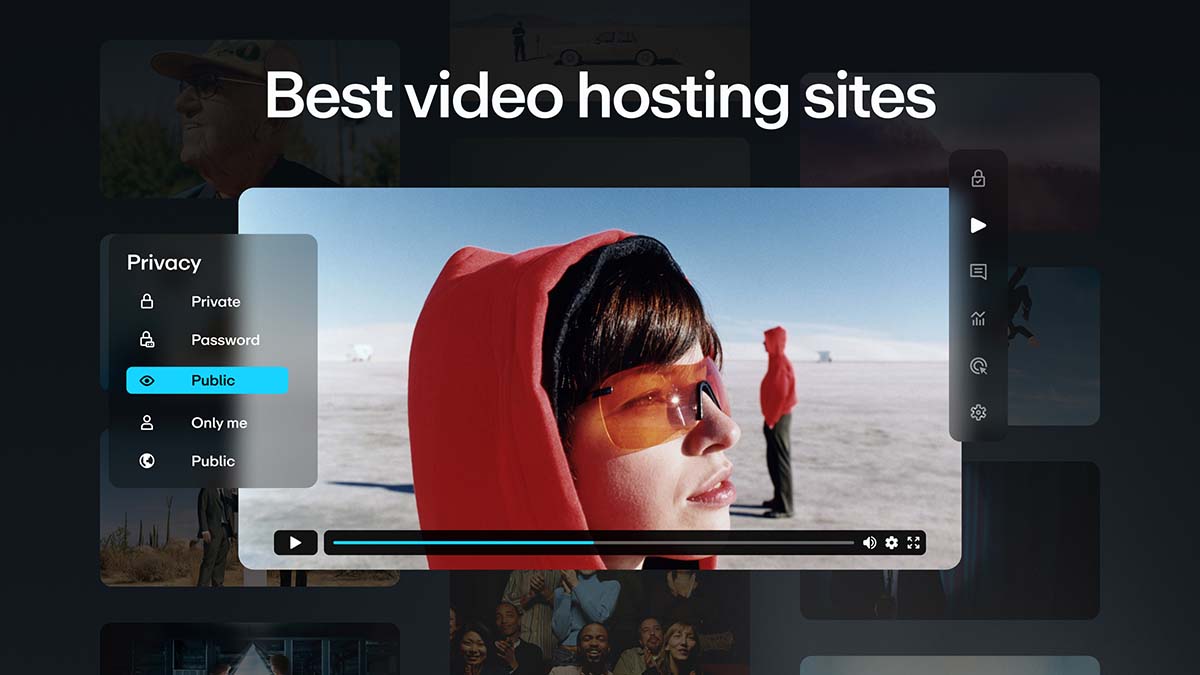The surge in online education has created numerous opportunities for teachers, coaches, and businesses to share their expertise through digital courses. If you’re an educator or a content creator trying to grow your brand, the video course hosting platform you choose can make or break the experience for you and your students.
The best platforms offer robust features that support every stage of the education journey, from course creation templates and video hosting capabilities to learner engagement tools and analytics.
This guide breaks down the top online learning platforms and educational video hosting options, exploring key features, benefits, and real-world use cases to help you make an informed decision.
Where to host online courses: Key aspects to consider
Here are several essential elements to evaluate when deciding what platform to use:
- Customization and branding: Look for a platform that allows you to tailor your user interface, brand your video player, and maintain complete control over your visual identity.
- Video quality and performance: High-definition playback, adaptive streaming, and secure hosting are non-negotiable for modern learning content.
- Analytics and learner insights: You’ll need robust data to track learner engagement and improve your course creation strategy over time.
- Integration with LMS and tools: Select a platform that seamlessly integrates with your existing learning management system (LMS) and supports essential tools, such as email automation and operational testing.
- Scalability and support: Whether you’re just starting or managing a complete online course catalog, your platform should be able to grow with you.
Vimeo checks all of these boxes. It empowers course creators and businesses to deliver high-quality, scalable video learning experiences that align with their brand and audience needs. Vimeo makes it easy to create courses, embed videos into your LMS, and gain data-driven insights to fuel your business.
7 best platforms for online courses: Which one fits your goals?
Below is a breakdown of the seven leading video hosting platforms. Consider your audience and business model when deciding which one is best for you.
1. Vimeo
Vimeo stands out from other video course hosting platforms due to its professional-grade video security and advanced customization options. Vimeo also offers advanced features, including 4K streaming, subscription management through Vimeo Streaming, and domain-level privacy.
With its scalable infrastructure and branded playback experiences, Vimeo is ideal for companies or creators looking to deliver professional-grade training and educational content with complete control over delivery and branding.
- Platform scale and reach: 287 million users, trusted by global brands
- Use case and content: Corporate training, educational institutions, subscription-based content
- Pricing options: Free basic plan, Pro, Business, Enterprise
- Performance features: 4K streaming, customizable players, chaptering, video analytics, password protection, domain-level privacy
- Main benefits: Embed into LMS, package videos as rentals or subscriptions using Vimeo OTT, host gated or live-streamed video content
- Limitations: Not a full LMS (but best when integrated with one)
Discover video education solutions from Vimeo →
2. Kajabi
Kajabi is designed to help knowledge creators build and market digital products. It consolidates web hosting, course creation, and sales funnels into a single dashboard, eliminating the need for third-party tools.
While it has less advanced video hosting capabilities than Vimeo, Kajabi excels in marketing automation, making it an excellent fit for those who want to focus on monetization and community building alongside course delivery.
- Platform scale and reach: 100k+ creators
- Use case and content: Courses, coaching, memberships, podcasts
- Pricing options: $149 to $399 per month
- Features and performance: Website builder, CRM, landing pages, course hosting
- Main benefit: Streamlined for solopreneurs
- Limitations: Less video-specific customization and analytics compared to Vimeo
3. Thinkific
Thinkific is a course creation platform known for its simplicity and strong support for structured learning experiences. It enables instructors to build comprehensive course pathways with multimedia lessons, quizzes, certificates, and completion tracking. While it doesn’t offer deep customization or advanced analytics, it’s suitable for creators seeking a budget-friendly solution to get started quickly.
- Platform scale and reach: 50k+ instructors, 100M+ enrollments
- Use case and content: Traditional online courses
- Pricing options: Free to $199 per month
- Features and performance: Drip content, custom domains, mobile app
- Main benefit: Great for beginners
- Limitations: Fewer advanced customization tools
4. LearnDash
LearnDash is a WordPress plugin that transforms your site into a full-featured LMS. It's popular among universities, enterprises, and independent educators who want to maintain complete control over their learning environment.
LearnDash supports drip scheduling, advanced quizzes, gradebooks, SCORM, and Tin Can xAPI, making it suitable for formal education and professional certification courses. Its strength lies in flexibility, but it requires some technical skill and familiarity with WordPress.
- Platform scale and reach: Widely used by universities and businesses
- Use case and content: Self-hosted online course creation
- Pricing options: $199 per year and up
- Features and performance: Gradebooks, quizzes, SCORM support
- Main benefits: Full control and integration with WordPress
- Limitations: Requires a technical setup
5. Skillshare
Skillshare operates more like a course marketplace than a hosting platform. It’s ideal for creators who want to reach a large, built-in audience without worrying about marketing or sales infrastructure.
While you can’t control pricing or student data, Skillshare gives you instant exposure to millions of users and a community-oriented learning environment. New instructors can use it or creatives focused on building an audience and testing course ideas before committing to a larger platform.
- Platform scale and reach: 12M+ students
- Use case and content: Creative and business-focused online courses
- Pricing options: Revenue share model
- Features and performance: Class projects, community feedback
- Main benefit: Built-in audience
- Limitations: Limited pricing control and brand presence
6. Udemy
Udemy is one of the largest online course platforms, offering tens of thousands of courses across a wide range of subjects. As a hosting option, it provides significant discoverability and marketing support but limits instructor control over pricing and branding.
Udemy handles hosting, payments, mobile optimization, and certification, making it easy for anyone to publish a course. But due to strict content guidelines and high competition, it’s best for instructors who are willing to trade autonomy for visibility and traffic.
- Platform scale and reach: 70k instructors, 60M+ students
- Use case and content: Massive, open-registration online courses
- Pricing options: Free to revenue-share
- Features and performance: Certification, reviews, mobile-friendly
- Main benefits: Huge reach and discoverability
- Limitations: Strict guidelines and lower pricing control
7. Teachable
Teachable is a creator-first platform that simplifies the course publishing process while offering enhanced monetization tools. It enables you to create branded course websites, accept payments worldwide, and issue certificates.
Teachable’s ease of use makes it great for solo creators and small teams, and its integration with popular email marketing and analytics tools helps you grow a sustainable online course business. While its customization options are less advanced than Vimeo or some WordPress-based tools, it’s a solid choice for launching a course fast with minimal technical barriers.
- Platform scale and reach: 100k+ creators
- Use case and content: Courses, coaching, digital downloads
- Pricing options: Free to $499 per month
- Features and performance: Built-in payments, certificates, and sales pages
- Main benefit: Simple to launch
- Limitations: Little to no visual customization
Comparison table: Top video course hosting platforms
Platform | Scale and reach | Use case and content | Pricing options | Features and performance | Main benefits | Limitations |
Vimeo | 287 million users | Corporate training, educational institutions, and subscription content | Free, Pro, Business, Enterprise | 4K streaming, customizable player, analytics, OTT support | Deep analytics, LMS integration, video monetization (rentals, subs) | Not a full LMS |
Kajabi | 100k+ creators | Coaching, memberships, courses, and podcasts | $149 to $399 per month | Website builder, CRM, landing pages | All-in-one business platform for solopreneurs | Limited video-specific features |
Thinkific | 50k+ instructors, 100M+ enrollments | Traditional online courses and schools | Free to $199per month | Quizzes, certificates, mobile app | Beginner- and a r-friendly, drag-and-drop builder | Limited customization |
LearnDash | Used widely in universities and enterprises | Self-hosted courses on WordPress | $199 per year and up | Gradebooks, quizzes, SCORM support | Full WordPress control | Requires tech setup |
Skillshare | 12M+ students | Creative and business content | Revenue share model | Class projects, community feedback | Built-in student base | No pricing control or branding |
Udemy | 70k instructors, 60M+ students | MOOCs across all subjects | Free, revenue share | Certification, reviews, mobile app | Massive reach and search visibility | Strict policies, low revenue control |
Teachable | 100k+ creators | Courses, coaching, digital products | Free to $499 per month | Payments, certificates, sales pages | Easy to launch, beginner-friendly | Limited design customization |
FAQ
How do I organize my online courses?
Start by outlining your learning objectives, then break your content into structured modules or lessons. Most online course platforms let you organize content using chapters, playlists, or drip schedules. Use quizzes and assessments to reinforce learning along the way.
How profitable is selling online courses?
Selling online courses can be highly profitable depending on your pricing, niche, and audience size. Some creators use courses to generate passive income, while others build full-time businesses. Choosing the best platform for online courses helps you scale and maintain profitability.
Can I host my online course on my website?
Yes, with tools like Vimeo or LearnDash, you can embed videos and build courses directly on your website. Embedding gives you complete control over branding, content access, and the learner experience.
Use Vimeo for e-learning and elevate your training strategy
Launching online courses involves using a platform that supports engagement, scalability, and measurable growth.
Vimeo’s education video solutions, as well as our learning and development tools, are purpose-built for educators and businesses that want to deliver exceptional learning experiences through video. With customizable players, robust analytics, seamless LMS integration, and monetization options like OTT and subscription management, Vimeo helps you elevate your online course business from day one.
Ready to launch or grow your e-learning program? Try Vimeo for professional-grade course hosting.



